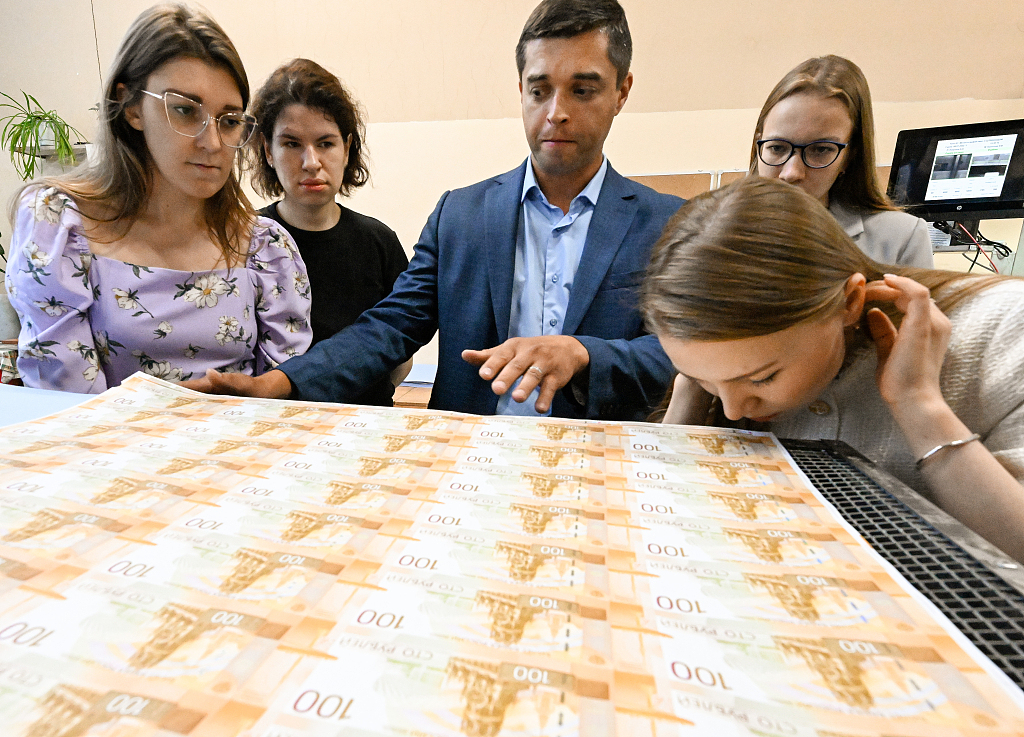
A tourist pays with digital Chinese yuan at the Happy Valley Beijing theme park in Beijing, China, June 16, 2021. /Xinhua
A tourist pays with digital Chinese yuan at the Happy Valley Beijing theme park in Beijing, China, June 16, 2021. /Xinhua
Editor's note: Peng Wensheng is chief economist and head of research at China International Capital Corporation and executive dean of CICC Global Institute. The article reflects the author's opinions and not necessarily the views of CGTN.
As the world reels under once-in-a-century impacts from COVID-19 and the Russia-Ukraine conflict, profound changes may again reshape the international monetary system, which has been dominated by the U.S. dollar. The system has recently become the subject of heated discussions around three key issues: First, the U.S. dollar's domestic and external values have diverged due to soaring inflation in the U.S. and appreciation of the dollar's exchange rates against other currencies. Second, under dual impacts of COVID-19 and the Russia-Ukraine conflict, financial assets denominated in U.S. dollar face a decline in their status as general assets. Third, Western countries' financial sanctions have triggered doubts about the security of reserve assets in U.S. dollar.
Globalization and financialization are the cornerstones of U.S. dollar dominance. Over the past four decades, neoclassical economics has guided policymakers around the world to promote financial liberalization and adopt macro policy frameworks built upon two pillars: inflation targeting and floating exchange rate. As a result, globalization and financialization have swept across the world and laid the cornerstone for the U.S. dollar regime, in which the U.S. plays a pivotal role as a financial center that provides safe assets and commercial financing. Therefore, the U.S. dollar has maintained its status as an international reserve currency, despite the diminishing importance of the U.S.'s real economy. However, globalization decelerated, and financial regulation tightened in the wake of the subprime crisis.
Deglobalization manifests itself in a shift of policymakers' goals from efficiency, which is marked by low cost, to economic and geopolitical targets. The switch implies that global supply is subject to more constraints, while governments play more important roles in resource allocation. Recent signs of deglobalization include technological competition between China and the U.S., impacts of COVID-19 and the Russia-Ukraine conflict on global value chains, sanctions and a decline in the "peace dividend." Deglobalization has posed challenges to value chain structures and international trade ties built over the past few decades.
De-financialization is visible in both debts and assets, i.e., a shift from private sector debts to government debts and from financial assets to real assets. Commercial banks' capacity for credit expansion is constrained by increasingly stringent financial regulation, while fiscal expansion has become increasingly important amid endeavors to cope with the impacts of COVID-19. The recent appreciation of the Russian ruble following financial sanctions on the country, a major energy exporter, well illustrates real assets' growing importance compared with financial assets. In fact, financial sanctions have further undermined financial assets' status as general assets.

Journalists watch the production process of Russian ruble banknotes during a press tour to the Printing Factory of Joint Stock Company "Goznak," in Moscow, Russia, July 6, 2022. /VCG
Journalists watch the production process of Russian ruble banknotes during a press tour to the Printing Factory of Joint Stock Company "Goznak," in Moscow, Russia, July 6, 2022. /VCG
With deglobalization and de-financialization eroding the two cornerstones of the U.S. dollar dominance, the international monetary system may evolve into a multipolar framework. From the perspective of payment systems, we believe China may leverage its status as the world's largest trading nation to seek multilateral non-U.S.-dollar payment mechanisms.
The supply of safe assets may also change while real assets are gaining importance. Apart from traditional government bonds, currency swap agreements between central banks and cooperation agreements on strategic commodity reserves may both serve as safe assets to some extent. In addition, interest-bearing central bank digital currencies facilitate the transition to a multipolar international monetary system by serving as both means of payment and safe assets.
The internationalization of the Chinese yuan faces both new opportunities and challenges. Deglobalization and de-financialization mean the U.S.'s international financial advantage may decline, while China's disadvantage in the financial sector may have fewer negative impacts on the country. Capital account liberalization does not have to be the focus of all the efforts to advance the Chinese yuan's internationalization. Instead, greater attention should be paid to the competitiveness of China's real economy. Competition and cooperation between China and the U.S. will likely take place mainly in the real economy, notably technological innovation and commodities, rather than the financial sector.
(If you want to contribute and have specific expertise, please contact us at opinions@cgtn.com. Follow @thouse_opinions on Twitter to discover the latest commentaries on CGTN Opinion Section.)

